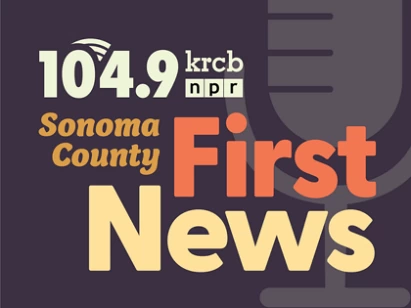 photo credit: Noah Abrams/KRCB
photo credit: Noah Abrams/KRCBA coho smolt from San Geronimo Creek
Adult salmon are in a tough spot - especially California’s King Salmon. Previous years of scarce rainfall contributed to a sharp fall off in their numbers.
But King aren’t the only salmon swimming upstream in the Golden State.
Their Coho cousins face many of the same challenges.
Experts are hoping conservation efforts along with fuller, cooler streams this year will chart a way back for the endangered population along much of the California coast.
Scientists and technicians are tracking that course, monitoring young salmon in countless rivers, creeks, and streams across the region.
San Geronimo Creek slithers through quaint hamlets and past groves of mystic redwoods before draining into the more impressive Lagunitas Creek in West Marin.
As cars trundle by above on Sir Francis Drake Boulevard, the water passes through a makeshift network of nets, ropes, and screens.
It's a trap.
"And so as you can see, it kind of like funnels down until we get to a pipe where then the fish go down the pipe and into the trap box," Said Ayano Hayes.
Hayes is a biologist with SPAWN - the Salmon Protection and Watershed Network.
What does the day-to-day work of coho conservation look like?
A typical Spring morning for Hayes starts with waders, boots, and the short walk down to San Geronimo Creek to check for smolts in SPAWN’s trap.
"A coho smolt is a salmon that's been in the creek for a year and a half growing in size foraging until this spring now in 2023 where they're starting to silver out, they're preparing for ocean conditions and they are heading downstream," Hayes said.
 photo credit: Noah Abrams/KRCB
photo credit: Noah Abrams/KRCBSPAWN's smolt trap seen from downstream
Those numbers offer a snapshot of conditions and provide data for decision-makers.
"With this smolt trap in place, we're capturing everything that's moving downstream," Hayes said.
Nonprofits like SPAWN and government organizations like Marin Water and the National Park Service monitor and tag coho smolts as part of the species’ recovery plan.
The Coho which spawn here belong to the federally endangered Central California Coast coho population. Though not much more than a modest stream, Marin Water’s Fish expert Eric Ettlinger said the Lagunitas Creek Watershed is considered a so-called “salmon stronghold”.
 photo credit: Noah Abrams/KRCB
photo credit: Noah Abrams/KRCBSPAWN Biologist Ayano Hayes and volunteer
Ken Wu work at a makeshift lab on the creek bank
"It's the largest remaining population of coho salmon south of Mendocino County," Ettlinger said. "And even on a statewide level, we've good numbers of salmon, but it's a critical population for coho salmon conservation in California."
Ettlinger said the population needs to be seen in context though.
"It's still a small population, it's a small remnant of what used to be here," Ettlinger said.
A big part of making sure Marin can support large numbers, is restoring habitat within the watershed - upper reaches trapped behind dams or otherwise compromised by human development.
Hayes explained what a salmon-friendly waterway looks like.
"For creating spawning habitat, it's really important that we have riffle zones, so riffle areas where there's a lot of bubbly currents, bubbly activity, cause this is where the benthic macroinvertebrates are," Hayes said. "This is where the most oxygen is, and so that's what the adult salmon are looking for."
Catch that word? Benthic macroinvertebrates. Those are the small animals and insect larvae that salmon eat.
Also important, making it easier for salmon to build their own nests, called redds.
"What we have discovered is that just by putting like wood structures, jams that will help slow the water down, slow any kind of gravel that might be moving down and actually let it kind of build up and create these gravel bars," Hayes said. "Allow the smaller pieces of gravel to settle and create those nice spawning grounds."
Hayes said the fish are very particular about their gravel as well.
"With the gravel size, it's important that they're about like golf ball size, maybe fist," Hayes said. "You don't want it to be too small like sand. They won't like to bury their nest in sand."
Climate and weather conditions have had a big impact too, said Ettlinger.
"The conditions for the eggs in 2021-22 were exceptional," Ettlinger said. "We started the winter off with a lot of rain. Adult salmon came in and they were able to spawn everywhere in the watershed."
As for this year - Ettlinger is concerned the stream of storms may have washed away coho eggs and younglings, but said it is still too early to tell.
"We’ll see this summer when we do our annual counts of juvenile salmon but one thing I am really looking forward to is a year and a half from now these smolts that are going out will be coming back and we could get one of the largest coho runs that we’ve seen in recent memory," Ettlinger said.
 photo credit: Noah Abrams/KRCB
photo credit: Noah Abrams/KRCBVolunteer Ken Wu inspects the trap for Coho smolts
moving through the downstream pipe
The deluges this year also affected Hayes and the SPAWN team, delaying their census.
"So we didn't get the trap in until about April 13th," Hayes said. "Ideally, we would've gotten the trap in 1st of April."
Hayes inspected the smolts at a makeshift lab on the creek bank.
"With getting length weights and also marking them, we sedate them slightly just to calm them down," Hayes said.
Instead of the usual fin clip, this year Hayes is using a “visible implant elastomer” - a sort of paint tag so fish can be tracked as they move through the watershed - but not every fish gets marked.
"No marking," Hayes said. "I'm not gonna mark it. I'm gonna send it downstream. He looks like he has claw marks along the body. We've actually seen that quite a bit. Like there's birds or maybe mergansers that are just trying to like catch the fish and they're, yeah, we're seeing the markings on their body."
Not every fish wants to cooperate either…
"All right, last coho smolt here, oh my goodness," Hayes said as smolt jumped out from a bucket towards the cool creek waters. "It's okay. I think that one was heading downstream...Did he really hop out of here?" Hayes asked. "Gosh. Yeah. I feel like the last couple of days they've been really jumpy.
 photo credit: Noah Abrams/KRCB
photo credit: Noah Abrams/KRCBSPAWN's smolt trap seen from upstream
They're like in a rush. They're like, we gotta go."
For Hayes, the smolt jailbreak tells the tale - as flows level, temperatures rise, the number of outgoing smolts declines - the Spring season - and the smolt traps’ days - are winding down.
How many return in the years ahead depends on ocean conditions.

 Live Radio
Live Radio




